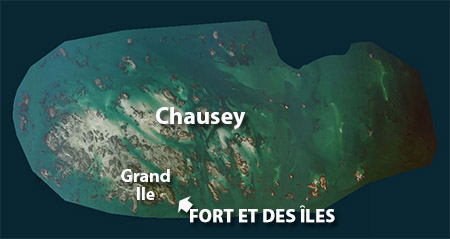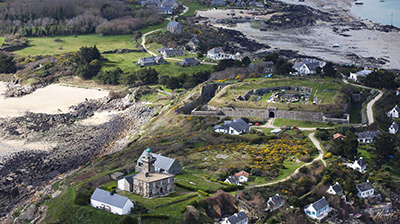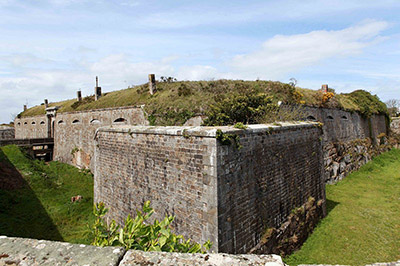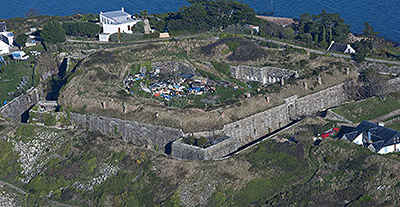 |
Fort et des Îles
Grand Île, Chausey, France
|
|
 |
Constructed: 1859-1866
Used by: France, Germany
Conflict in which it participated:
First World War, sort of
Also known as: Château Renault
|
It may surprise some to learn that the French do not refer to the English Channel, the body of water that separates southern England from northern France, as "the English Channel." Instead, it is known as le Manche, "the Sleeve." This semantic issue is generally unimportant, which is why I chose to lead off with it. But what is important, in the context of this page, is Chausey. One of the lesser-known Channel Islands (Guernsey, Jersey and Alderney are generally more familiar to most), Chausey holds the distinction of being the only Channel Island that is French territory.
|
 |
|
|
All of the Channel Islands were absorbed by the Duchy of Normandy in 933AD. In 1022, Richard II (963-1026), Duke of Normandy, gave Chausey to the Benedictine monks of Mont Saint-Michel, who built a priory there. The Channel Islands became English in 1066 due to William the Conqueror (1028-1087)'s conquestatory nature, and Chausey was administered from Jersey until 1499, when the Jerseyites reportedly abandoned the island to the French.
Why Chausey was so abandoned is not precisely known. As the islands in question weren't on any major sea lanes, however, it was probably just determined that the effort and expense of maintaining an English presence on Chausey simply wasn't worth it.
|
 The tiny smattering of rocks that is Chausey. The term "Grand Île" is of course relative...it's only about a mile across. Such teeniness makes one wonder why all the bother, but...historically, man has fought and died over much smaller rocks. The tiny smattering of rocks that is Chausey. The term "Grand Île" is of course relative...it's only about a mile across. Such teeniness makes one wonder why all the bother, but...historically, man has fought and died over much smaller rocks. |
 |
Which of course did not prevent the English from insisting they still had a claim to Chausey for the next few centuries. Being somewhat off the beaten track yet right there off the French Coast, with the added dubiousness of ownership, the hundreds of tiny islets and sheltered coves of Chausey made this island chain a perfect fit for smugglers and pirates.
In 1559, the French built the Fortress of Matignon on Grand Île. A square fortlet with a round tower, this fort was built to proclaim French command of Chausey. |
|
Matignon was enlarged in the 1740's, to which the Royal Navy even more loudly proclaimed, "oh no you don't," and destroyed the fort in 1744. Which is what the French got for building a square fort in the starfort age. For shame, France.
The French tried again, building another fort on the other side of Grand Île shortly thereafter...which the British also destroyed, in 1756. Clearly, England's position on the matter was that France would be permitted to pretend that it owned Chausey, but would not be permitted to fortify it.
|
Chausey was ignored by all during the Napoleonic Wars (1803-1815). By the time Napoleon III (1808-1873) scuttled onto the world stage in the mid-19th century, however, France was in a much more powerful naval position than had previously been the case. In his process of ramping up the pressure against Great Britain, Napoleon III ordered the construction of the starfort of our current interest on the southern tip of Grand Íle in 1859.
Though certainly faithful to the starfort concept, the thickness of Fort et des Îles' walls, and teeny protrusions that are more caponieres than bastions, put it pretty solidly into the category of polygonal forts.
|
 |
 Low tide! Everything on Chausey's Grand Île except the fort seems to be in great condition. Low tide! Everything on Chausey's Grand Île except the fort seems to be in great condition. |
|
By the 1850's, polygonal forts were what all the cool kids were building. In theory, Chausey's new fort made it every bit as up-to-date militarily as its fellow Channel Island Alderney, a tiny island which had been slathered with sixteen individual forts by the British over the preceding three centuries...Fifteen of those forts were technologically outclassed by Fort de les Îles, although fifteen old-fashioned forts (some more starrish than others) would probably have been enough to cause the French trouble should they try to invade. Which they did not.
|
 Fort de les Îles' eastern bastion. Pointez-vous! Fort de les Îles' eastern bastion. Pointez-vous!
And check out those demilune-style firing slits! Groovy! |
 |
Fort et des Îles was completed in 1866, but by then Napoleon III's attention had turned away from Britain and his eye fixed, disastrously, on Prussia. Worried that Otto von Bismarck (1815-1898)'s efforts to unify the German states and Prussia would upset the European balance of power, France declared war on the Kingdom of Prussia on July 16, 1870.
By January of 1871, the French army had been destroyed, Napoleon III had been captured and Paris was surrounded by Germans. Perhaps Napoleon III should have contented himself with throwing his weight around the English Channel. |
|
While still surrounded by the German army, the mob in Paris awoke and wrested control of the city from its provisional government. From March until May of 1871, a revolutionary movement called the Commune was the ruling body of Paris, while the Germans ringing the city scratched the heads beneath their pickelhauben and wondered what in the world these crazed Frenchmen were doing.
The Commune was frantically repressed by what was left of the French army at the end of May 1871. Something like 18,000 Parisians were killed in this bloody spasm, and another 25,000 Communards were imprisoned...some of them, briefly, at Fort et des Îles.
|
In 1906, after a whopping 47-year military career of imprisoning some Parisians for a short period and little else, Fort et des Îles was retired. The general consensus by the beginning of the 20th century was that starforts and polygonal forts were no longer a reasonable method by which to protect a seacoast or project power.
Fortunately, the Franco-Prussian War (1870-1871) begat the First World War (1914-1918), which brought life back to the Fort et des Îles in the form of 300 or so German and Austrian prisoners, who were incarcerated at the fort by the French.
|
 |
 It's difficult to say for sure what that colorful mass is on the fort's parade ground, but it sure looks like somebody's laundry. It's difficult to say for sure what that colorful mass is on the fort's parade ground, but it sure looks like somebody's laundry. |
|
Following the war, the Fort et des Îles was once again abandoned. In 1922 it was purchased by French auto-industry pioneer Louis Renault (1877-1924), who spent two years restoring the fort, and building some residences on Grand Île, at his own expense. The fort thus became known as Château Renault.
Once the First World War had begotten the Second World War (1939-1945) and Nazi Germany occupied France, Renault was forced to make a choice between operating his massive automotive industry under the Germans, or fold his arms, refuse to cooperate and likely be shot, along with many of his employees. He chose to continue making vehicles, which did aid the German war effort to a degree, but...it's difficult to imagine how he might had reasonably done otherwise. Regardless, once the Nazis were ejected from France, a bloody witch hunt to expose and punish all Frenchmen who made an attempt to live under the German occupation without demonstratively trying to undermine it got underway, and Renault was painted as a collaborator. He died in a French prison in 1944...not at the Fort et des Îles (which was probably not still being referred to as Château Renault), which would have been too ironic.
Today, Chausey is populated by about a dozen families year 'round, a few of which live in the Fort et des Îles. There is a tourist population that descends upon Grand Île every summer, which led to an unfortunate event in 2015.
The naked bodies of two tourists were found dead at the foot of the Fort et des Îles on August 20, 2015. The man and woman, around 30 years of age, had apparently been making love atop the fort and (one assumes mistakenly) fallen to their deaths. Police described a "lover frolic gone wrong" as the cause of this "amorous catastrophe."
The ten-room Hotel de Fort et des Îles is open from April to November, for those who wish to try their luck atop the fort's walls.
|
|
|
|
|
|
 |




